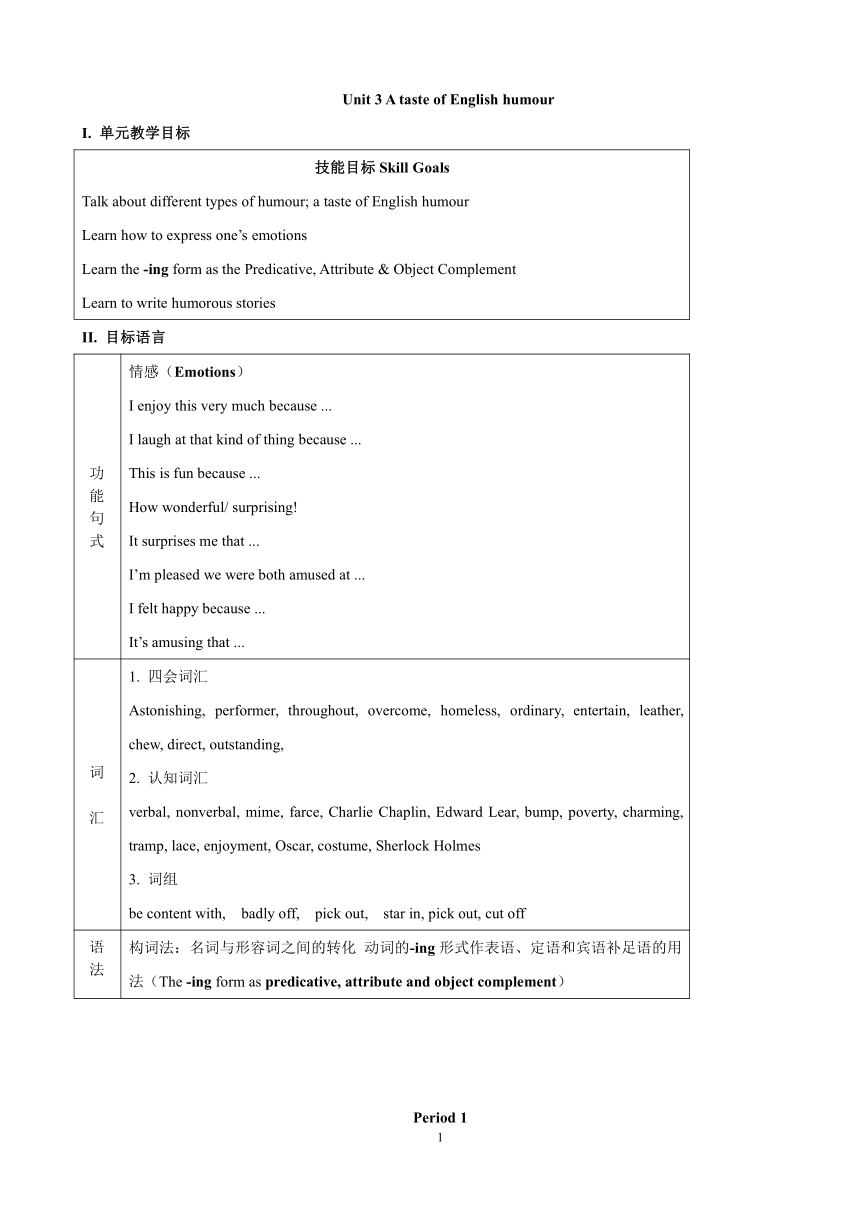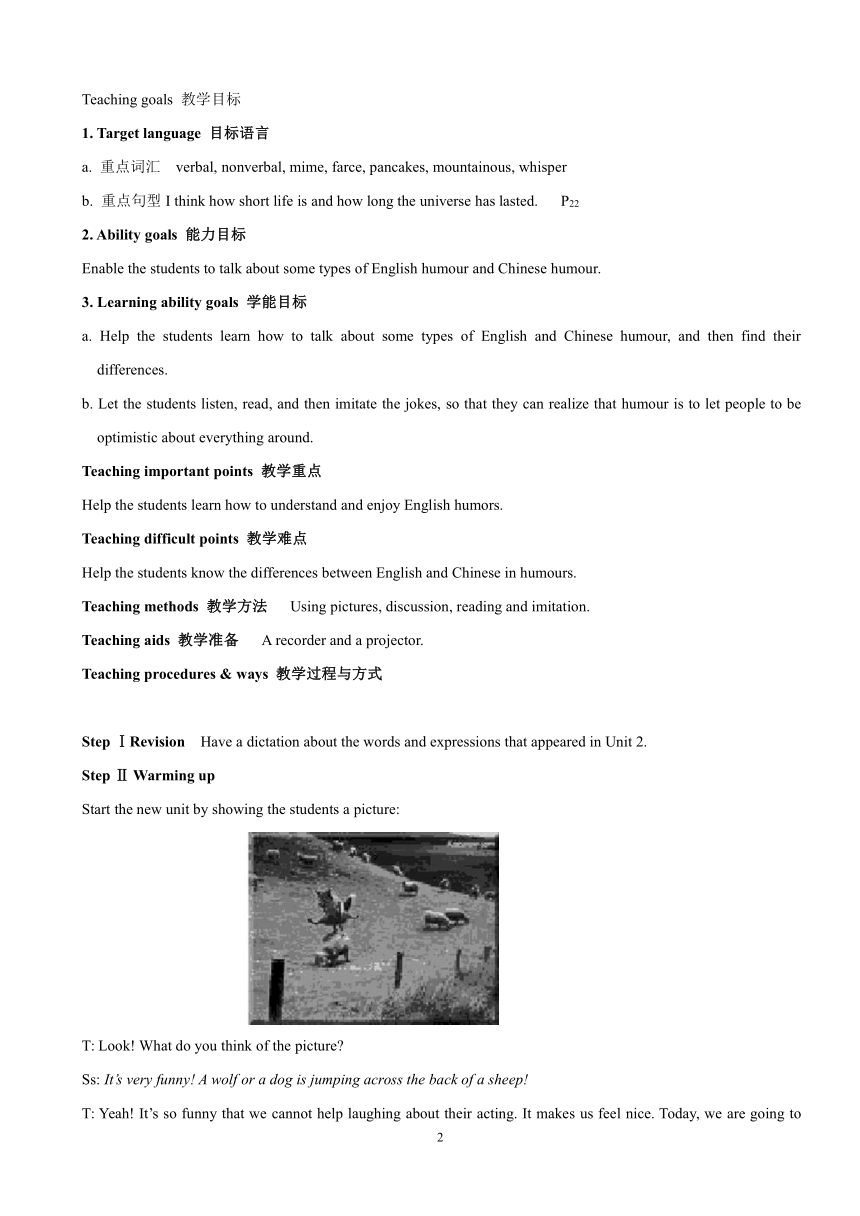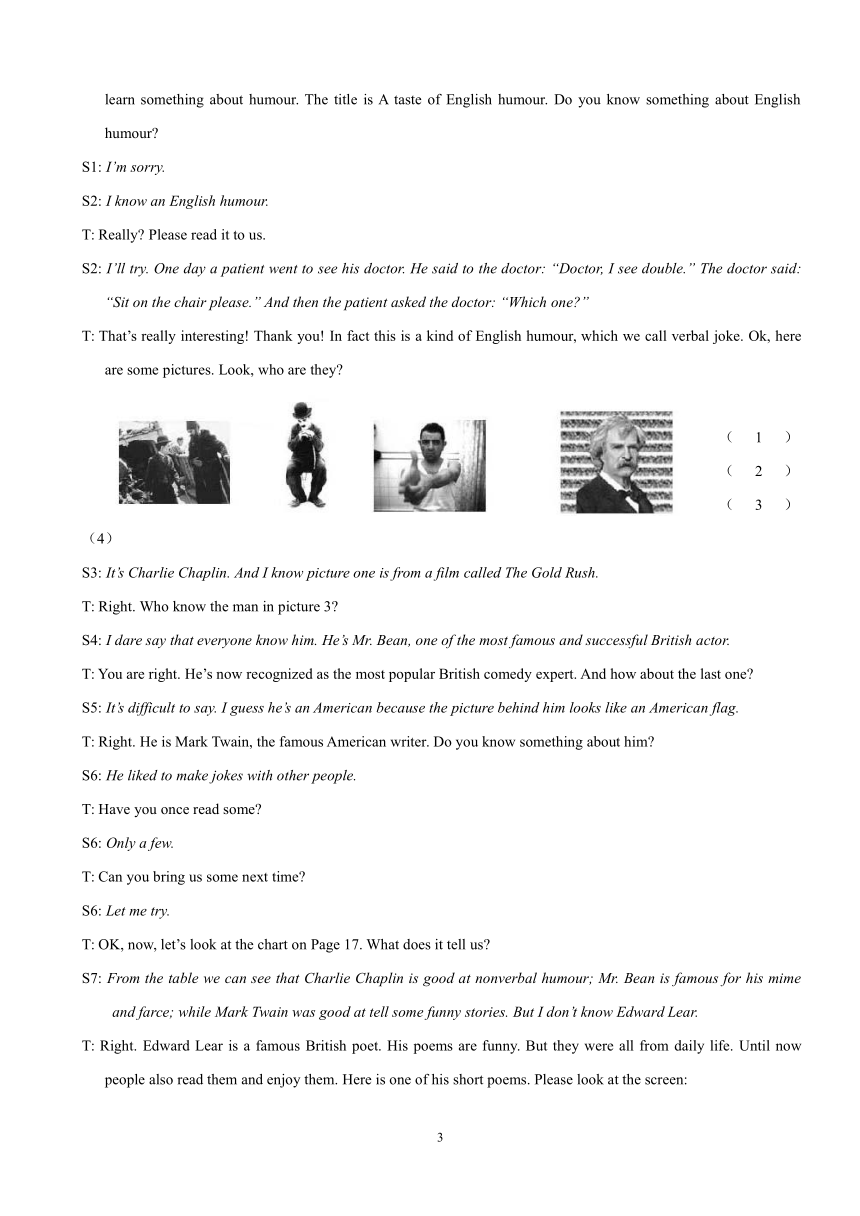人教高中英语必修四Unit 3 A taste of English humour Warming Up 教案
文档属性
| 名称 | 人教高中英语必修四Unit 3 A taste of English humour Warming Up 教案 |  | |
| 格式 | zip | ||
| 文件大小 | 120.6KB | ||
| 资源类型 | 教案 | ||
| 版本资源 | 人教版(新课程标准) | ||
| 科目 | 英语 | ||
| 更新时间 | 2020-01-26 21:11:08 | ||
图片预览



文档简介
Unit 3 A taste of English humour
I. 单元教学目标
技能目标Skill GoalsTalk about different types of humour; a taste of English humour Learn how to express one’s emotions Learn the -ing form as the Predicative, Attribute & Object Complement Learn to write humorous stories
II. 目标语言
功 能 句 式 情感(Emotions) I enjoy this very much because ... I laugh at that kind of thing because ... This is fun because ... How wonderful/ surprising! It surprises me that ... I’m pleased we were both amused at ... I felt happy because ... It’s amusing that ...
词 汇 1. 四会词汇 Astonishing, performer, throughout, overcome, homeless, ordinary, entertain, leather, chew, direct, outstanding, 2. 认知词汇 verbal, nonverbal, mime, farce, Charlie Chaplin, Edward Lear, bump, poverty, charming, tramp, lace, enjoyment, Oscar, costume, Sherlock Holmes 3. 词组 be content with, badly off, pick out, star in, pick out, cut off
语 法 构词法:名词与形容词之间的转化 动词的-ing形式作表语、定语和宾语补足语的用法(The -ing form as predicative, attribute and object complement)
Period 1
Teaching goals 教学目标
1. Target language 目标语言
a. 重点词汇 verbal, nonverbal, mime, farce, pancakes, mountainous, whisper
b. 重点句型I think how short life is and how long the universe has lasted. P22
2. Ability goals 能力目标
Enable the students to talk about some types of English humour and Chinese humour.
3. Learning ability goals 学能目标
a. Help the students learn how to talk about some types of English and Chinese humour, and then find their differences.
b. Let the students listen, read, and then imitate the jokes, so that they can realize that humour is to let people to be optimistic about everything around.
Teaching important points 教学重点
Help the students learn how to understand and enjoy English humors.
Teaching difficult points 教学难点
Help the students know the differences between English and Chinese in humours.
Teaching methods 教学方法 Using pictures, discussion, reading and imitation.
Teaching aids 教学准备 A recorder and a projector.
Teaching procedures & ways 教学过程与方式
Step ⅠRevision Have a dictation about the words and expressions that appeared in Unit 2.
Step Ⅱ Warming up
Start the new unit by showing the students a picture:
T: Look! What do you think of the picture?
Ss: It’s very funny! A wolf or a dog is jumping across the back of a sheep!
T: Yeah! It’s so funny that we cannot help laughing about their acting. It makes us feel nice. Today, we are going to learn something about humour. The title is A taste of English humour. Do you know something about English humour?
S1: I’m sorry.
S2: I know an English humour.
T: Really? Please read it to us.
S2: I’ll try. One day a patient went to see his doctor. He said to the doctor: “Doctor, I see double.” The doctor said: “Sit on the chair please.” And then the patient asked the doctor: “Which one?”
T: That’s really interesting! Thank you! In fact this is a kind of English humour, which we call verbal joke. Ok, here are some pictures. Look, who are they?
(1) (2) (3) (4)
S3: It’s Charlie Chaplin. And I know picture one is from a film called The Gold Rush.
T: Right. Who know the man in picture 3?
S4: I dare say that everyone know him. He’s Mr. Bean, one of the most famous and successful British actor.
T: You are right. He’s now recognized as the most popular British comedy expert. And how about the last one?
S5: It’s difficult to say. I guess he’s an American because the picture behind him looks like an American flag.
T: Right. He is Mark Twain, the famous American writer. Do you know something about him?
S6: He liked to make jokes with other people.
T: Have you once read some?
S6: Only a few.
T: Can you bring us some next time?
S6: Let me try.
T: OK, now, let’s look at the chart on Page 17. What does it tell us?
S7: From the table we can see that Charlie Chaplin is good at nonverbal humour; Mr. Bean is famous for his mime and farce; while Mark Twain was good at tell some funny stories. But I don’t know Edward Lear.
T: Right. Edward Lear is a famous British poet. His poems are funny. But they were all from daily life. Until now people also read them and enjoy them. Here is one of his short poems. Please look at the screen:
There was an old Man with a breadThere was an old man with a bread, Who said, “It’s just as I feared! Two owls and a hen, Four larks and a wren, Have all built their nests in my bread!”
T: In these two poems we can see that Edward Lear used a kind of magnification to make his poem funny. But because the sense of humour of English and Chinese is different, sometimes what they feel funny would not sound funny to us. But if you want to make fun of one of your friends, you can send them to him/her. They will be surprise to see these. Well, do you know these persons in the pictures? What are they good at? Nonverbal, mime and farce, funny stories or funny poems?
(1) (2) (3) (4)
S8: Picture 1 is Chen Peisi. I think he is famous for his mime and farce.
S9: Picture 2 is Zhao Benshan. He is famous for his Xiao pin. And he is also for his mime, I think.
S10: The two persons in picture 4 are Liu Quanhe and Liu Quanlin. They are good at Ya ju (哑剧).
T: Do you know the third person? No? He is the famous cross talk actor—Hou Baolin. When he was living, he was the most popular actor. Many of his works are the classic. OK, now can you finish the last column of the chart?
The Suggested answers:
English humourNonverbal Mime and farce Verbal jokes Funny stories Funny poems Chinese humourPantomime (哑剧) 刘全和、刘全林 Funny plays 陈佩斯、赵本山 Cross talk 侯宝林、马季 Jokes Doggerel (打油诗)
Step Ⅲ Reading on P22
The purpose of this reading is to introduce the kind of humour we can laugh at -verbal jokes. They use a “play on words” to be funny. Let the students read the three jokes and then match the joke with the explanation.
T: Well, boys and girls, just now we learned something about English and Chinese jokes. Now let’s read some English jokes on Page 22. I’ll give three minutes for you to read them and then match the joke with the explanation. If you like, you may have a discussion. And then we’ll check the answer. OK, read them.
The students read and finish their task, and the teacher can show some other jokes on the screen. After they have finished the task, check the answer and ask them to enjoy the jokes on the screen.
T: Have you finished the reading? Are the jokes funny?
Ss: Yes, they are very funny. We’ve never found that English jokes so funny.
T: What’s the answer?
S11: The answer is 1 to B, 2 to C and 3 to A.
T: Good. Now, please look at the screen. Here are more jokes on it. Read them and enjoy them. If you have some troubles in understanding, discuss, or ask me.
Give the students some time to read the jokes:
Ss: We’re laughing to death!
T: Don’t do that, another joke is waiting for you. Please read the neat joke on Page 22. And then finish the question followed.
Give the students three minutes to do it.
T: Now decide which of these two kinds of jokes you like better. Give your reason.
S12: I find the first kind jokes are easier to understand.
S13: Those jokes on the screen are the funnies ones, I think.
S14: We must understand the background of the funny story at first, and then we can know what a humor Sherlock Holmes was. I think to understand this kind of jokes needs wisdom to understand. We must know that he was a detective, so he was always thinking of the things such as stealing.
T: What you said is reasonable. Now let’s listen to the tape, pay attention to the intonation, and try to bring out the humorous meaning.
If time permits, the teacher can ask some students to act out the jokes.
Step IV Speaking
T: Now, we’ve learned some jokes and listened to some too. How about speaking out what you feel funny in class? I’ll give you five minutes to prepare this task, and then ask some of you to tell us your story. There are some steps for you to finish the task. If you think they are useful, follow them.
Five minutes later.
S15: My story is one day Lian Hong was standing by the window, talking with other students. Ren Xinglian came up. She wanted to make a joke with Lian and gave her a surprise. So she rushed towards Lian and kicked her at the same. But to all of us surprise, Ren slipped on the floor! Everybody laughed to bend their backs, me too.
T: Me too! OK, this class is full of joy. We know that in our life, there are full of happiness, sorrows, boredoms, and joys. When we meet with sorrows or boredoms, don’t forget to read these jokes. Maybe they can bring you sunshine. Am I right?
Ss: Yes. Thank you.
Step V Homework
T: Today’s homework is to preview the Reading material and finish the
Comprehending ahead. And I have a wish that at the beginning of each class, one of
our classmates can give us a joke, to bring smile into the classroom. Do you agree?
Ss: That’s a good idea.
T: Let’s begin from Group one. One of you will tell a joke to us at the beginning of next class. Don’t forget it. Ok, class is over. See you next time.
Ss: See you.
同课章节目录
